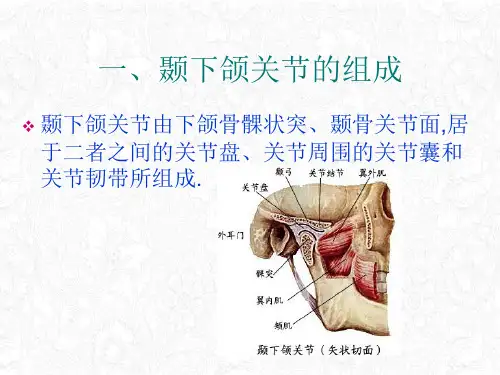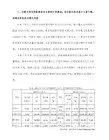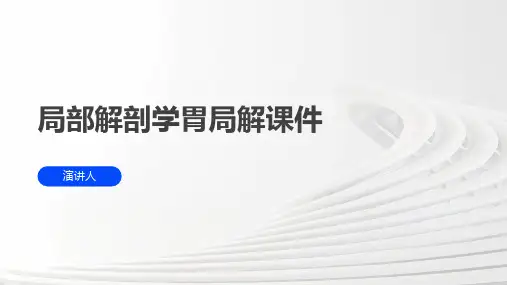局解课件总结
- 格式:doc
- 大小:374.50 KB
- 文档页数:22









![[医学]局解实验课件](https://uimg.taocdn.com/33b6ccbaed3a87c24028915f804d2b160b4e86aa.webp)

脊柱区Muscles of BackSuperficial group–Trapezius 斜方肌–Latissimus dorsi 背阔肌–Levator scapulae 肩胛提肌–Rhomboideus 菱形肌Deep group–Splenius 夹肌–Erector spinae 竖脊肌Triangle of auscultation 听诊三角(肩胛旁三角)Boundaries•Latissimus dorsi•Trapezius•The medial border of thescapulaInferior lumbar triangle 腰下三角–Boundaries•Lower part of the lateralmargin of latissimus dorsi•Posterior free border ofthe obliquus externusabdominis•Iliac crestSuperior lumbar triangle腰上三角–Boundaries•Serratus posterior inferior•Erector spinae•Obliquus internusabdomins上肢Cephalic vein 头静脉•Arises from the lateral side of the dorsal venous rete on the back of hand•Winds around the lateral border of the forearm; it then ascends into the cubital fossaand up the front of the arm on the lateral sideof the biceps.•It continues up in the deltopectoral groove and then to the infraclavicular fossa, where itpierces clavipectoral fascia to drain intoaxillary vein.Basilic vein 贵要静脉•Arises from the medial side of the dorsal venous rete of hand•Winds around the medial border of the forearm•Then ascends into the cubital fossa and up the front of the arm on the medial side of thebiceps to middle of the arm where it piercesthe deep fascia and joins the brachial vein oraxillary veinMedian cubital vein 肘正中静脉•Links cephalic vein and basilic vein in the cubital fossa•It is a frequent site for venipuncture to remove a sample of blood or add fluid to thebloodAxillary fossa 腋窝Boundaries•Apex–Middle 1/3 of clavicle–Lateral border of first rib–Upper border of the scapula•Base–Skin–Superficial fascia–Axillary fascia 腋筋膜(cribriformfascia 筛状筋膜)•The medial wall–Serratus anterior–Upper four ribs and intercostalspaces•The lateral wall–Intertubercular groove–Long head and short head of bicepsbrachii–Coracobrachialis•The anterior wall–Pectoralis major–Pectoralis minor–Subclavius–Clavipectoral fascia 锁胸筋膜•The posterior wall–Subscapularis–Teres major–Latissimus dorsi–ScapulaContents•Axillary a. and principal branches•Axillary v. and tributaries•Brachial plexus and branches•Axillary lymph nodes•Loose connective tissueTrilateral foramen 三边孔(trilateral space 三边隙)•Boundaries–Superior: teres minorsubscapularislateral border of scapula,articular capsule of shoulder joint–Inferior: teres major–Lateral: long head of tricepsbrachii•Structures pass through the trilateral foramen–Circumflex scapular a. and v. Quadrilateral foramen 四边孔(quadrilateral space 四边隙)•Boundaries–Superior: teres minorsubscapularisarticular capsule of shoulder joint–Inferior: teres major–Medial: long head of tricepsbrachii–Lateral: surgical neck of humerus •Structures pass through the quadrilateral foramen–Axillary n.–Posterior humeral circumflex a.and v.Axillary artery•Begins at the at lateral border of first rib as a continuation of subclavian artery•At the lower border of teres major it becomes the brachial artery.•Divided into three parts by overlying pectoralis minor Branches•First part–superior thoracic a.–thoracoacromial a.•Second part–lateral thoracic a.•Third part–subscapular a.•throcodorsal a.•circumflex scapular a.–anterior humeral circumflex a.–posterior humeral circumflex a. Brachial artery 肱动脉–Begins at the lower border of theteres major as a continuation ofaxillary artery–Terminates opposite the neck ofradius by dividing into radial andulnar arteriesBranches•Deep brachial a. 肱深动脉–Follows the radialnerve into the spinalgroove of thehumerus•Superior ulnar collaeral a.尺侧上副动脉–follows the ulnarnerve•Inferior ulnar collateral a.尺侧下副动脉–Takes part in theanastomosis aroundthe elbow joint.Median nerve 正中神经–Origin•Arises from the medial andlateral cord of the brachialplexus–Course•Descends on the lateral sideof brachial artery•Halfway down the arm, itcrosses the brachial artery toreach its medial side Humeromuscular tunnel 肱骨肌管•Composition–Formed by triceps brachii肱三头肌and groove for radial nerve ofhumerus 肱骨桡神经沟•Structures passing through the tunnel–Radial nerve 桡神经–Deep brachial a. and v. 肱深动静脉•Radial collateral a. 桡侧副动脉•Middle collateral a. 中副动脉Cubital fossa 肘窝Boundaries–Laterally: brachioradialis肱桡肌–Medially: pronator teres旋前圆肌–Roof: skin, superficial facia, deepfascia and aponeurosis of biceps–Floor: brachialis 肱肌, supinator 旋后肌and capsule of elbow joint 肘关节囊Contents•biceps brachii tendon 肱二头肌腱•Medial to biceps brachii tendon–Brachial a. 肱动脉-divides intoradial and ulnar a., usually at apex offossa–Brachial v. 肱静脉–Median n. 正中神经•Lateral to the biceps brachii tendon–Radial n. 桡神经–Lateral antebrachial cutaneous n. 前臂外侧皮神经•Deep cubital lymph nodesCarpal canal 腕管–Composition:Formed by flexorretinaculum 屈肌支持带and carpalgroove 腕骨沟–Structures passing through thecarpal tunnel•Median n. 正中神经•Tendons of flexor digitorumsuperficialis 指浅屈肌andflexor digitorum profundus指深屈肌enclosed bycommon flexor synovialsheath 屈肌总腱鞘•Tendon of flexor pollicislongus 拇长屈肌enclosedby synovial sheath for flexorpollicis longus 拇长屈肌腱鞘Superficial palmar arch 掌浅弓•Formed by ulnar artery and superficial palmar branch of radial artery•The curve of arch lies across the palm, level with the distal border of fully extended thumb •Gives rise to three common palmar digital arteries 指掌侧总动脉(each then dividesinto two proper palmar digital arteries 指掌侧固有动脉) and one ulnar palmar artery ofquinary finger 小指尺掌侧动脉Deep palmar arch 掌深弓•Formed by radial artery and deep palmar branch of ulnar artery•The curve of arch lies across upper part of palmar at level with proximal border ofextended thumb•Gives rise to three palmar metacarpal arteries 掌心动脉to joint the distal ends ofthe corresponding common palmar digitalarteriesMedian n. 正中神经–Muscular branches: supply thenarexcept adductor pollicis, first twolumbricales–Cutaneus branches: supply skin ofthenar, central part of palm, palmaraspect of radial three and one-halffingers, including middle and distalfingers on dorsum–Recurrent branch of the mediannerve正中神经返支–lies deep to the skin anddeep fascia overlying theanterior margin of the thenarnear the midline of the palmUlnar n. 尺神经–Muscular branches supplyhypothenar muscles, interossei, 3rdand 4th lumbricales and adductorpollicis–Cutaneus branches supply skin ofhypothenar, palmar surface of ulnarone and one-half fingers, ulnar halfof dorsum of hand, posterior aspectof ulnar two and one-half fingers下肢Landmarks of lower limb•Gluteal region and thigh–anterior superior iliac spines anteriorinferior iliac spines 髂前下棘–tubercle of iliac crest 髂结节–ischial tuberosity 坐骨结节–greater trochanter 大转子–pubic tubercle 耻骨结节–pubic crest 耻骨嵴–superior border of pubic symphysis •Knee–patella ligament 髌韧带–tuberosity of tibia 胫骨粗隆–medial and lateral condyles 内外侧髁–medial and lateral epicondyles 内、外上髁–tendon of biceps femoris 股二头肌腱–tendons of semitendinosus andsemimembranosus 半腱、半膜肌腱•Leg–anterior border of tibia 胫骨前缘–head of fibula 腓骨头–neck of fibula 腓骨颈•Ankle and foot–medial and lateral malleolus 内、外侧踝–calcaneal tuberosity 跟骨结节–tuberosity of navicular bone 舟骨粗隆–tuberosity of fifth metatarsal bone第五跖骨粗隆Superficial veins:–Great saphenous vein 大隐静脉•Drains the medial end ofdorsal venous arch of footand passes upward directlyin front of the medialmalleolus.•Then ascends in companywith the saphenous n. in thesuperficial fascia over themedial side of the leg.Small saphenous v. 小隐静脉–Arises from the lateral part of thedorsal venous arch of foot–Ascends behind lateral malleolus andthen runs up the midline of the backof the leg–Pierces the deep fascia and enters thepopliteal v.–Drains the lateral side of the foot andankle and the back of the leg Structures passing through suprapiriform foramen (from lateral to medial side)–Superior gluteal n. 臀上神经–Superior gluteal a. 臀上动脉–Superior gluteal v. 臀上静脉Structures passing through infrapiriform foramen (from lateral to medial side)–Sciatic n. 坐骨神经–Posterior femoral cutaneous n. 股后皮神经–Inferior gluteal n. 臀下神经–Inferior gluteal a., v. 臀下动、静脉–Internal pudendal v., a.阴部内动、静脉–Pudendal n. 阴部神经Structures passing through small sciatic foramen (from lateral to medial side)–Internal pudendal v., a.阴部内动、静脉–Pudendal n. 阴部神经Superficial inguinal lymph nodes–Superior group:•Lies just distal to theinguinal ligament•Receive lymph vessels fromanterior abdominal wallbelow umbilicus, glutealregion, perineal region,external genital organs–Inferior group:•Lies vertical along theterminal great saphenous v.•Receives all superficiallymph vessels of lower limb,except for those from theposterolateral part of calf–Efferent vessels drain into the deepinguinal ln. or external iliac ln. Fascia lata 阔筋膜–Iliotibial tract 髂胫束•laterally the deep fasciaforms a thick band•from the iliac tubercle to thelateral condyle of tibial–Saphenous hiatus 隐静脉裂孔• A gap in the deep fasicawhich lies about 4 cm belowand lateral to the pubictubercle. The falciformmargin 镰状缘is thelower lateral border of theopening, which lies anteriorto the femoral vessels.•Filled with loose connectivetissue called the cribriformfascia 筛筋膜Lacuna musculorum 肌腔隙–Boundaries:•Anteriorly: lateral portion ofinguinal ligament•Posterolaterally: ilium•Medially: iliopectinal arch–Contents:Iliopsoas 髂腰肌•femoral n. 股神经•lateral femoral cutaneous n.股外侧皮神经Lacuna vasorum 血管腔隙–Boundaries:•Anteriorly: medial portion ofinguinal ligament•Posteriorly: fascia ofpecteineus and pectinealligament•Medially: lacuna ligament•Laterally: iliopectinal arch–Contents:•Femoral sheath 股鞘•Femoral a. and v. 股动、静脉•Femoral branch ofgenitofemoral n. 生殖股神经股支•Lymphatic vessels Femoral triangle 股三角–Boundaries•Superiorly (base) : inguinalligament 腹股沟韧带•Laterally: medial border ofsartorius 缝匠肌内侧缘•Medially: medial border ofadductor longus 长收肌内侧缘•Apex: continuous withadductor canal 收肌管•Anterior wall: fascia lata 阔筋膜•Posterior wall: consists ofiliopsoas 髂腰肌, pectineus耻骨肌and adductor longus长收肌from lateral tomedial side–Contents:from lateral to medial•Femoral n. 股神经•Femoral sheath 股鞘•Femoral a. 股动脉•Femoral v. 股静脉•Femoral canal 股管•Deep inguinallymph nodes 腹股沟深淋巴结•Fatty tissue 脂肪组织Femoral canal 股管–Femoral ring 股环•Anteriorly:inguinal ligament•Medially: lacuna lig. 腔隙韧带•Posteriorly: pecteneal lig.耻骨梳韧带•Laterally: femoral v. 股静脉•Superior: covered byfemoral septum 股环隔Adductor canal 收肌管–Boundies•Anterior wall: adductorlamina大收肌腱板andsartorius 缝匠肌•Lateral wall: vastus medialis股内侧肌•Posteomedial wall: adductorlongus 长收肌andadductor magmus 大收肌–Contents•Saphenous n. 隐神经•Femoral a. and femoral v.股动、静脉•lymphatic vessels and looseconnective tissueSciatic nerve 坐骨神经•Course–Arises from the sacral plexus–Leaves pelvis through infrapiriformforamen to enter gluteal region–Runs inferiorly laterally deep togluteus maximus–Passing midway between the greatertrochanter of femur and ischialtuberosity to back of thigh–Lying deep to long head of bicepsfemoris,–Normally divided into tibial andcommon peroneal nerves just abovepopliteal fossa•Innervates–Semitendinosus 半腱肌–Semimembranosus 半膜肌–Biceps femoris 股二头肌–Hip and knee joints 髋关节和膝关节Popliteal fossaBoundaries:–Superolaterally: Biceps femoris 股二头肌–Superomedially: semitendinosusand semimembranosus 半腱肌和半膜肌–Inferiorly:lateral and medial headsof gastrocnemius 腓肠肌内、外侧头–Roof: deep fascia–Floor:•popliteal surface of thefemur•posterior capsule of the kneejoint•fascia covering popliteus –Contents–Nerves•Tibial nerve 胫神经•Common peroneal nerve 腓总神经–Popliteal vein and its tributaries腘静脉及属支–Popliteal artery and its branches腘动脉及分支–Popliteal lymph nodes 腘淋巴结Malleolar canal 踝管•Boundaries–Formed by medial surface ofcalcaneus, flexor retinaculum andmedial malleolus•Structures passing through the malleolar canal–Tibialis posterior 胫骨后肌–Flexor digitirum longus 趾长屈肌–Posterior tibial a. v. and n. 胫后动脉、静脉–Tibial n. 胫神经–Flexor hallucis longus 长屈肌头部•眉弓superciliary arch•眶上切迹supraorbital notch•眶下孔infraorbital foramen•颏孔mental foramen•翼点pterion•颧弓zygomatic arch•耳屏tragus•髁突condylar process•乳突mastoid process•前囟点bregma•人字点lambda•枕外隆突external occipital protuberance Parotid duct 腮腺管•Arises front anterior border of gland•Lies 1.5 cm below and parallel tozygomatic arch•Passes forward over masseter,pierces the buccinator and oralmucosa to open opposite secondupper molar toothStructures vertical passing through the parotid gland•External carotid a. 颈外动脉•Superficial temporal a.颞浅动脉•Superficial temporal v.颞浅静脉•Retromandibular vein下颌后静脉•Auriculotemporal n.耳颞神经Structures transversal passing through the parotid gland•Maxillary a. & v.上颌动、静脉•Transverse facial a. & v.面横动、静脉•Branches of facial n.面神经的分支The structures from superficial to deep•Branches of facial nerve 面神经的分支•Retromandibular vein 下颌后静脉•External carotid a. 颈外动脉andAuriculotemporal n. 耳颞神经Layers of frontoparietooccipital regionConsists of five layersThe superficial 3 layer are closely knit together, called scalp 头皮1. Skin 皮肤thick and hair bearing and contains numerous sebaceous glands皮厚、腺多、血运丰富2. The superficial fascia 浅筋膜•Dense connective tissue that binds the skin to the underlying epicranial aponeurosis •The vasculature of the scalp runs primarily in this layer. It is rich and widely anastomosis.•Wounds of the scalp bleed profusely but heal well.a. v. and n. in superficial fascia•Anterior group–Supratrochlear a. v. n. 滑车上动、静脉和神经–Supraorbital a. v. n. 眶上动、静脉和神经•Posterior group–Occipital a. v. 枕动、静脉–Greater occipital n. 枕大神经3. Epicranial aponeurosis and occipitofrontalis 帽状腱膜和枕额肌•It is interposed between the frontalis and occipitalis portions of the occipitofrontalismuscle.•These muscles place the aponeurosis under tension so that deep transverse lacerations ofthe scalp gape widely•坚韧致密,前连额腹,后连枕腹,4. Subaponeurotic loose connective tissue(space)腱膜下疏松结缔组织(间隙)•Contains a rich network of deep arteries and veins. Therefore, this layer has been calledthe “dangerous area”.•Infection may spread to the substance of the bones, to venous channels within the cranialcavity, or to the brain.5. Pericranium 颅骨外膜•Fuses firmly with bone at the sutures and withthe periosteum of the adjacent bone, thuslimiting the subperiosteal space.•薄而致密,易于颅骨分离,如有血肿,与骨一致Hypophysis and hypiphyseal fossa 垂体与垂体窝•Shape and position–Pea-sized organ, attached byinfundibulum to hypothalamus, liesin hypophysial fossa–Consists of two parts:•Adenohypophysis•Neurohypophysis•Relationship–Anterior-tuberculum sellae–Posterior-dorsum sellae–Anterolateraly-optic canal–Above-diaphragm sellae, opticchiasma and optic nerve–Laterally-cavernous sinus–Below-sphenoid sinus Cavernous sinus 海绵窦•Position: lies on each side of sella turcica•Traversing the cavernous sinus–internal carotid artery 颈内动脉–abducent nerve 展神经•Traversing the lateral wall of the cavernous sinus–oculomotor nerve 动眼神经–trochlear nerve 滑车神经–ophthalmic nerve 眼神经–maxillary nerve 上颌神经颈部Landmarks of the neck⏹Hyoid bone 舌骨⏹Thyroid cartilage 甲状软骨⏹Cricoid cartilage 环状软骨⏹Catotid tubercle 颈动脉结节⏹Sternocleidomastoid 胸锁乳突肌⏹Suprasternal fossa 胸骨上窝⏹Greater supraclaviclar fossa 锁骨上大窝Cervical fascia 颈筋膜Superficial layer of cervical fascia 颈筋膜浅层(investing fascia 封套筋膜)⏹Encloses trapezius, sternocleidomastoid,posterior belly of digastric and parotid andsubmandibular glands⏹Attached to bony landmarks of upper andlower boundaries of neck and zygomatic archof facePretracheal layer 气管前层⏹Lies deep to the infrahyoid muscle⏹Encloses viscera of neck: pharynx, larynx,trachea, esophagus, thyroid gland andparathyroid glands⏹Completely surrounds thyroid gland, forminga sheath for it, and bind the gland to larynx toform suspensory ligament of thyroid gland甲状腺悬韧带⏹Extends from arch of cricoid cartilage,thyroid cartilage and hyoid bone to fibrouspericardium of superior mediastinum Prevertebral layer 椎前层⏹Lies anterior to bodies of cervical vertebraeand prevertebral muscles; extends from baseof skull downward into the superiormediastinum, continuous with anteriorlongitudinal lig. and endothoracic fascia⏹Covers subclavian vessels and roots ofbrachial plexus⏹Extends into upper limb as axillary sheath★Carotid triangle 颈动脉三角⏹Boundaries❑Anterior border ofsternocleidomastoid❑Superior belly of omohyoid❑Posterior belly of digastic⏹Covered by skin, superficial fascia, platysmaand investing fascia⏹Deep-prevertebral fascia⏹Medial -lateral wall of pharynxContents❑Common carotid a. and its branches❑Internal jugular v. and its tributaries❑Hypoglossal n. with its descendingbranches❑Vagus nerve❑Accessory nerve❑Deep cervical lymph nodes Muscular triangle 肌三角•Bounded by midline of the neck, superior belly of the omohyoid and anterior border ofthe sternocleidomastoid.•Covered by skin, superficial fascia, platysma, anterior jugular v., and investing fascia •Deep-prevertebral fasciaThyroid gland 甲状腺•Shape and position–H-shape–Left and right lobes: lie on either sideof inferior part of larynx and superiorpart of trachea, extend from middleof thyroid cartilage to level of sixthtrachea cartilage–Isthmus: overlies 2nd to 4th trachealcartilage–Pyramidal lobe: some times arisesfrom isthmusCoverings of the thyroid gland•False capsule: a sheath of pretracheal fascia which is attached to arch of cricoid andthyroid cartilages to form the suspensoryligament of thyroid gland, hence, the thyroidgland moves with larynx during swallowingand oscillates during speaking•True capsule: fibrous capsule•Space between sheath and capsule of thyroid gland: there are loose connective tissue,vessels, nerves and parathyroid glands Relations of the thyroid gland•Anteriorly:–Skin–superficial fascia–investing fascia–Infrahyoid muscles and pretrachealfascia•Posteromedially:–Larynx and trachea–Pharynx and esophagus–Recurrent laryngeal nerve•Posterolaterally:–Carotid sheath with common carotida., internal jugular v., and vagus n.–Cervical sympathetic trunkArteries of the thyroid gland•Superior thyroid a. 甲状腺上动脉–Branch of external carotid a.–Runs superficial and parallel to theexternal branch of superior laryngealn. to reach the upper pole of thyroidgland–Gives off superior laryngeal a. incompany with internal branch ofsuperior laryngeal n.•Inferior thyroid artery 甲状腺下动脉–Branch of thyrocervical trunk ofsubclavian a.–Turns medially and downward,reaches the posterior border of thethyroid gland, where it is closelyrelated to the recurrent laryngeal n.–Supplies inferior pole of thyroidgland•Arteria thyroidea ima 甲状腺最下动脉–May arise (4%) from thebrachiocephalic a. or aortic arch Superior laryngeal n. 喉上神经•Internal branch 内支:which pierces thyrohyoid membrane to innervates mucousmembrane of larynx above fissure of glottis •External branch 外支:is fine n., which descends in company with the superiorthyroid a. and supplies cricothyroid Recurrent laryngeal nerves 喉返神经•Ascend in tracheo-esophageal groove•Pass deep to the lobe of the thyroid gland and come into close relationship with the inferiorthyroid a.•Cross either in front of or behind the artery•Nerves enter larynx posterior to cricothyroid joint, the nerve is now called inferiorlaryngeal nerve喉下神经•Innervations: laryngeal mucosa below fissure of glottis, all laryngeal laryngeal musclesexcept cricothyroidRelationship of arteries to the laryngeal nerves •The superior thyroid a. is closely related near its origin to the superior laryngeal n.•Section of the nerve would anaesthetise the laryngeal mucosa and abolish the coughreflex, so increasing the risk of food or aforeign body entering the trachea.•The inferior thyroid a. is closely related to the recurrent laryngeal n. as it enters the gland.•Section of the nerve would result in paralysis of muscles that move the vocal cords on thatside.Parathyroid gland 甲状旁腺•Position–Two superior parathyroid glands: lieat junction of superior and middlethird of posterior border of thyroidgland–Two inferior parathyroid glands: lienear the inferior thyroid artery, closeto the inferior poles of thyroid gland Relations of cervical part of trachea•Anteriorly–Skin–Superficial fascia–Investing fascia–Suprasternal space and jugular arch–Infrahyoid muscles and pretrachealfascia–Isthmus of thyroid gland ( in front ofthe 2nd to 4th tracheal cartilage)–Inferior thyroid v. and unpairedthyroid venous plexus–Arteria thyroid ima (if present)–Thymus, left brachiocephalic v. andaortic arch in child•Superolaterally–lobes of the thyroid gland (down asfar as the sixth ring)•Posteriorly–Esophagus–R. & L. recurrent laryngeal nerves •Posterlaterally–Cervical sympathetic trunk–Carotid sheathCarotid sheath 颈动脉鞘⏹Formed by components of all three layers ofdeep cervical fascia⏹Contains common and internal carotidarteries, internal jugular vein, and vagusnerve胸部Landmarks of thorax•Jugular notch corresponds with–The 2th thoracic vertebra in male, the3th thoracic vertebra in female •Sternal angle corresponds with–Connects 2nd costal cartilagelaterally–The lower border of 4th thoracicvertebra–The bifurcation of trachea in theadult–The beginning of aortic arch whichends posteriorly at the same level–The esophagus is crossed by the leftmain bronchus•Xiphoid process-xiphisternal synchondrosis lies opposite the body of the 9th thoracicvertebra•Clavicle–Inferior fossa of clavicle–Coracoid process•Ribs and intercostal spaces•Costal arch–Infrasternal angle 胸骨下角–Xiphocostal angle 剑肋角•Mammary papilla 乳头Thoracic wall 胸壁(层次)Superficial structures•Skin•Superficial fascia–Superficial n.•Supraclavicular n.•Anterior and lateralcutaneou sbranches ofintercostal n.T2 Sternal angleT4 NippleT6 Xiphoid processT8 Costal archT10 UmbilicusT12 Midpoint between umbilicusand symphysis pubis–Superficial a.–Superficial v.•Thoracoepigastric v.胸腹壁静脉•Lateral thoracic v. Mamma 乳房Structures•Contains skin, mammary glands and adipose tissue•Consists of 15 to 20 Lobes of mammary gland 乳腺小叶that radiate outward fromthe nipple•lactiferous duct 输乳管•lactiferous sinus 输乳管窦•Suspensory ligaments of breast 乳房悬韧带(cooper’s ligaments): connective tissue septathat extend from the skin to the deep fascia Lymphatic drainage of breast•Into pectoral ln. from lateral and central parts of breast•Into apical and supraclavicular ln. from superior part of breast•Into parasternal ln. from medial part of breast •Into interpectoral ln. from deep part of breast •The lymphatic capillaries of breast form an anastomosing network which is continuousacross the midline with that of the oppositeside and with that of the abdominal wall Deep structures•Deep fascia–Superficial layer–Deep layer—clavipectoral fascia •Muscles of thorax–Pectoralis major 胸大肌–Pectoralis minor 胸小肌–Subclavius 锁骨下肌–Serratus anterior 前锯肌–Intercostales externi 肋间外肌–Intercostales interni 肋间内肌–Intercostales intimi 肋间最内肌–Transverses thoracis 胸横肌Intercostal space•Eleven spaces between ribs•Intercostal muscles–Intercostales externi 肋间外肌•Extends down and anteriorlyfrom rib above to rib below•Replaced anteriorly byexternal intercostalmembrane•Action: raise ribs for forcedinspiration–Intercostales interni 肋间内肌•Extends up and anteriorlyfrom rib below to rib above•Replaced posteriorly byexternal intercostalsmembrane•Action: depress ribs forforced expiration–Intercostales intimi 肋间最内肌•Incomplete, thin, closelyapplied to intercostalesinterni•Intercostal a. and v.–Posterior intercostals arteries 肋间后动脉–subcostal artery 肋下动脉•Intercostal n.–Intercostal nerves 肋间神经(anteriorrami of T1- T11)–Subcostal nerve 肋下神经(anterior ramus of T12)–from superior to inferior: vein, artery,nerve (V AN)Internal thoracic vessels•Internal thoracic a. 胸廓内动脉•Internal thoracic v. 胸廓内静脉Endothoracic fascia 胸内筋膜– A thin layer of connective tissue–Separates the parietal pleura from thethoracic wallCupula of pleura 胸膜顶: extends up into the neck, over the apex of lung, 2.5cm above the medial third of claviclePleural cavity 胸膜腔–Potential space between visceral andparietal pleural–Contains a small amount of pleuralfluid–Subatmospheric pressure in it Pleura recesses 胸膜隐窝•Potential spaces of pleural cavity which lungs are not occupied in quiet respiration•Costodiaphragmatic recess 肋膈隐窝–slit-like space between costal anddiaphragmatic pleurae on each side–The lowest area of pleural cavity •Costomediastinal recess 肋纵隔隐窝–On the left side between themediastinal pleural and costal pleura Lower margins of pleura cross the 8th, 10th, 11th ribs, and 12th ribs at the midclavicular lines, the midaxillary lines, scapular line, and the sides of the vertebral column, respectively.Hilum of lung 肺门middle of medial surface, which is adepression where the bronchi,vessels, and nerves enter the lung Root of lung 肺根ContentsPrincipal bronchusPulmonary artery and veinNerves and lymphatic vesselsSurrounded by connective tissueOrder of structures in the root of lungFrom before backward: V. A. B.From above downward:L: A. B. V.R: B. A. V.Relations of left root of lungAnterior: phrenic n .andpericardiacophrenic vesselsPosterior: thoracic aorta and vagus n.Superior: aortic archInferior: pulmonary lig.Relations of right root of lungAnterior: phrenic n., pericardiacophrenicvessels, superior vena cava, partpericardium, and right atriumPosterior: vagus n.Superior: azygos v.Inferior: pulmonary lig.The Mediastinum 纵隔Concept• A broad central partition that separates the two laterally placed pleural cavities.•It extends from the sternum to the bodies of the vertebrae, and from the superior thoracicaperture to the diaphragm.Subdivisions of mediastinumSuperior mediastinum 上纵隔Locating-from inlet of thorax to plane extending from level of sternal angle anteriorly to lower border of T4 vertebra posteriorlyContentsSuperficial layerThymusThree veinsLeft brachiocephalic v.Right brachiocephalic v.Superior vena cavaMiddle layerAotic arch and its three branchesPhrenic n.Vagus n.Posterior layerTracheaEsophagusThoracic ductInferior mediastinum下纵隔Anterior mediastinum 前纵隔LocationPosterior to body of sternum andattached costal cartilages, Anterior toheart and pericardiumMiddle mediastinum 中纵隔Location-between anterior mediastinum andposterior mediastinum。